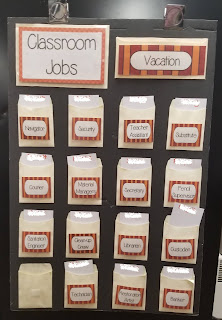When I came up with my classroom jobs, my goal was to have names of jobs that mimic real occupations. Obviously, there's not a career in sharpening pencils, so some of the names are a bit of a stretch. But many of them give me a chance to talk about different kinds of jobs the scholars might be interested in one day.
This is the board I organize my jobs. It's a poster from Dollar Tree with laminated job title card that are velcroed to pockets. That way, if I decide to change some of the jobs, it's easy to switch the cards out. I currently have space for 16 jobs, but I only have 15 scholars this year, so I removed one of them. And the scholars names are written on the top of index cards. When I have more scholars than jobs, those who don't have a job for the week are "on vacation."
Here's a list of the all classroom jobs with description, both current and past:
Navigator – line leader
Security – helps remind other scholars how to behave in the hallway
Teacher assistant – helps with any miscellaneous task or when a task is too big for one of the other jobs
Substitute – does the job for anyone that is absent
Courier – takes notes or items to the office or other teachers
Material manager – helps pass out papers and materials
Secretary – updates the calendar and schedule at the end of the day
Pencil supervisor – collects and sharpens pencils at the end of the day
Sanitation engineer – take out recycle and trash at the end of the day
Clean-up crew – make sure all supplies are put away and rugs are straightened at the end of the day
Librarian – organize and straighten the classroom library at the end of the day
Custodian – make sure floor is clean at the end of the day
Technician – check Chromebook station is tidy at the end of the day
Restoration artist – clean the whiteboards and reset lunch magnets at the end of the day
Banker – helps work with the money used in our classroom economy
Photographer – uses classroom camera to take photos
Center Clerks – helps with organizing materials with centers
Mailman – pass out papers into the scholars' mailboxes
Zookeeper – helps take care of the class pet
News Anchor – shares news with the class
Navigator – line leader
Security – helps remind other scholars how to behave in the hallway
Teacher assistant – helps with any miscellaneous task or when a task is too big for one of the other jobs
Substitute – does the job for anyone that is absent
Courier – takes notes or items to the office or other teachers
Material manager – helps pass out papers and materials
Secretary – updates the calendar and schedule at the end of the day
Pencil supervisor – collects and sharpens pencils at the end of the day
Sanitation engineer – take out recycle and trash at the end of the day
Clean-up crew – make sure all supplies are put away and rugs are straightened at the end of the day
Librarian – organize and straighten the classroom library at the end of the day
Custodian – make sure floor is clean at the end of the day
Technician – check Chromebook station is tidy at the end of the day
Restoration artist – clean the whiteboards and reset lunch magnets at the end of the day
Banker – helps work with the money used in our classroom economy
Photographer – uses classroom camera to take photos
Center Clerks – helps with organizing materials with centers
Mailman – pass out papers into the scholars' mailboxes
Zookeeper – helps take care of the class pet
News Anchor – shares news with the class






































